PHYSICS FORM TWO STATIC ELECTRICITY
The Concept of Static Electricity
Explain the concept of static electricity
Static
electricity refers to the accumulation of electric charges on the
surface of an object. These charges are in a stationary state (at rest).
The study of electric chargers at rest is known as electrostatics. It
studies about the charges at stationary state. These charges can be
moved away from the object y means of electric current when connected to
the circuit.
The Orign of Charges
Explain the origin of charges
The knowledge of static electricity came as early as the 6th
century BC (600 BC). It was first discovered by the Greek ancients who
rubbed amber and observed that it was able to carry attract dusts and
leaves. During those times they believed that there are charges which
make two things repel or attract each other.
Therefore, people knew about charges as result of rubbing process between two objects or materials.
When
a piece of amber, plastic, polythene, or hard rubber is rubbed with
fur, electrons are transferred from fur to the other material. Fur
acquires net positive charge, since it has fewer electrons than protons.
Similarly, the amber, plastic, or hard rubber acquires a net negative
charge since they have excess electrons.
Combing
hair charges the plastic comb by transferring charges from hair onto
it. If placed near small pieces of paper, the plastic comb will attract
the pieces of paper. This is because the comb has been charge with
negative charges.
Rubbing glass (perspex) with silk causes the glass to acquire a net positive charge.
The two Types of Charges
Identify the two types of charges
There are two types of charges; -
- Positive charges – they are protons in nature and originate from the nucleus of an atom. A positive charge is represented by the ‘+’ sign. It has charge of +1.6 x 10-19 C.
- Negative charges – they are electrons in nature and they move around the nucleus of an atom in shells. Electrons are lighter compared to protons. Electron charge is represented by the ‘-‘sign. It has a charge of -1.6 x 10-19.
Identification of charge
Suspend
a polythene rod A rubbed with fur. Bring another polythene rod B rubbed
with fur up to the rod A. Take a plastic rod and rub it with fur. Bring
the plastic rod to up to the suspended rod A. Repeat the exercise with
acetate and glass rod rubbed with silk cloth.
Observation
An
electrified polythene rod repels another electrified polythene rod. An
acetate rod rubbed with silk repels another acetate rod rubbed with silk
cloth but it attracts a plastic rod rubbed with fur.
Explanations
Polythene
and plastic when rubbed with fur becomes electrified with the same kind
of electricity known as negative electricity (charge).
Acetate
and glass when rubbed with silk cloth becomes electrified with the same
kind of electricity called positive electricity(charge).
Charging is the process of electrifying a body.
A
positively charged body carries positive charges and a negatively
charged body carries negative charges.The symbols used for positive and
negative charges are + and – respectively.
The Fundamental Law of Static Electricity
State the fundamental law of static electricity
The Fundamental law of electrostatic charges states that:“Like charges repel each other while unlike charges attract each other”
That
means, a positive charge will attract a negative charge but two
positive charges or two negative charges cannot attract rather repel.

Charging Bodies Using Different Methods
Charge bodies using different methods
In
order to understand the process of charging we have to understand the
structure of bodies or things. All bodies are made up of extremely
small, indestructible bits of matter called atoms.
An
atom consists of a nucleus surrounded by electrons. The nucleus
consists of proton and neutron.The protons are positively charged while
electrons are negatively charged and the neutrons are neutral.
The whole atom is electrically neutral because it contain equal number of protons and electrons.
The following are the methods of charging;
- Rubbing
- Induction
- Contact
Charging by rubbing
A
polythene rod rubbed with fur becomes negatively charged.Rubbing
results in the transfer of electrons from fur to the polythene rod.
Fur
becomes positively charged because some of its electrons are
transferred to the polythene rod.The polythene gains excess electrons
and hence it becomes negatively charged.

Note:It is only the electrons in matter which can be transferred by rubbing.
Charging by induction
A charged polythene rod is held near uncharged copper rod suspended from a cotton thread.
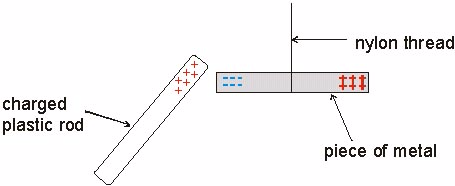
The
electrons of the copper rod are repelled by the negatively charged
polythene rod.Hence the electrons move to the far side of the copper
leaving behind a net positive charge on the side facing the polythene
rod.
Touch
the copper rod with your finger when the charged rod is still in
position. The electrons from copper rod flow through your body to the
earth. Leaving it with a net positive charge. Remove the finger from the
copper rod and finally remove the charged polythene rod.
The
rod has therefore been positively charged by electrostatic
induction.The charges that appear on the copper rod are called induced
charges.
Charging by contact
A
charged body (e. g; positively charged metal can) is brought in contact
with uncharged body B. When in contact, negative charges from the
uncharged body are attracted by the positive charges of the metal can.
Finally, the body B will remain with a net positive charge. Therefore,
body B has been charged with positive charges.

The Structure of a Gold-leaf Electroscope
Describe the structure of a gold-leaf electroscope
The instrument used to detect the presence of electric charges is called gold leaf electroscope. It consists of an insulated brass rod with two pieces of thin gold foil at one end and a brass cap at the other end.
When
the brass cap is touched with a charged object the leaves of the
electroscope spread out. This is because the charge on the object is
conducted through the brass cap and the brass rod to the leaves.
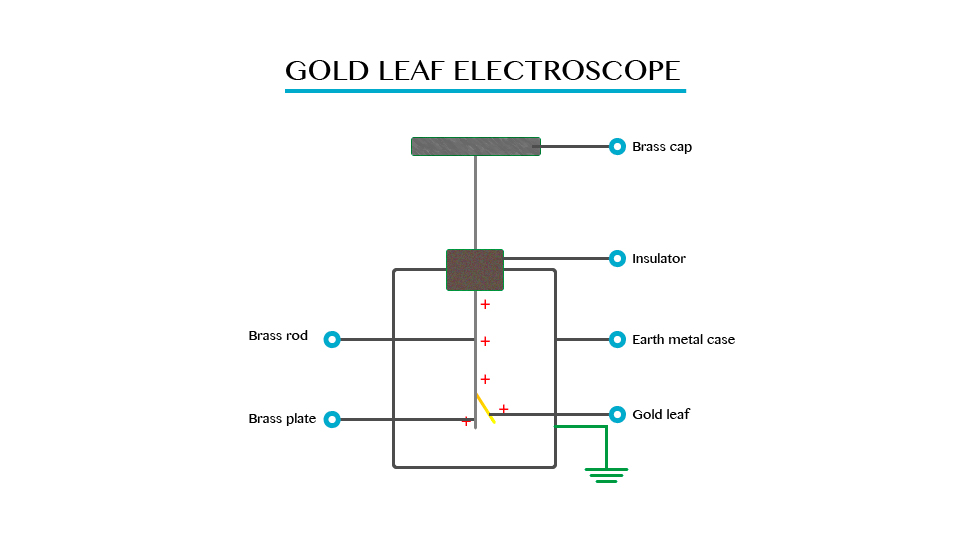
As they received the same kind of charge, the leaves repel each other and thus spread apart, this is charging by contact.
If
you touch the brass cap with your finger, the charge is transferred
through your body to the earth and the leaves of the electroscope then
collapse together.
Function of an electroscope
- Testing for the sign of the charge on the body.
- Identifying the insulating properties of materials.
- Detecting the presence of charge on a body.
The Sign of Charges
Determine the sign of charges
The
true sign on a body has to be determined before use; the instrument
that can be used to determine the presence of charge is called an
electrophorus.
An
electrophorus consists of a circular slab of insulating material
(polythene) together with a brass disc (conductor) on an insulating
handle.
An
electrophorus works by electrostatic insulation and hence can be used
to generate positive charges from single negative charges. The charge
produced on the insulating slab is negative. The top disc is then placed
on it. Since the surface is only in contact at relatively few points, a
positive charge is induced on the lower surface and corresponding
negative charge is produced on its top surface.
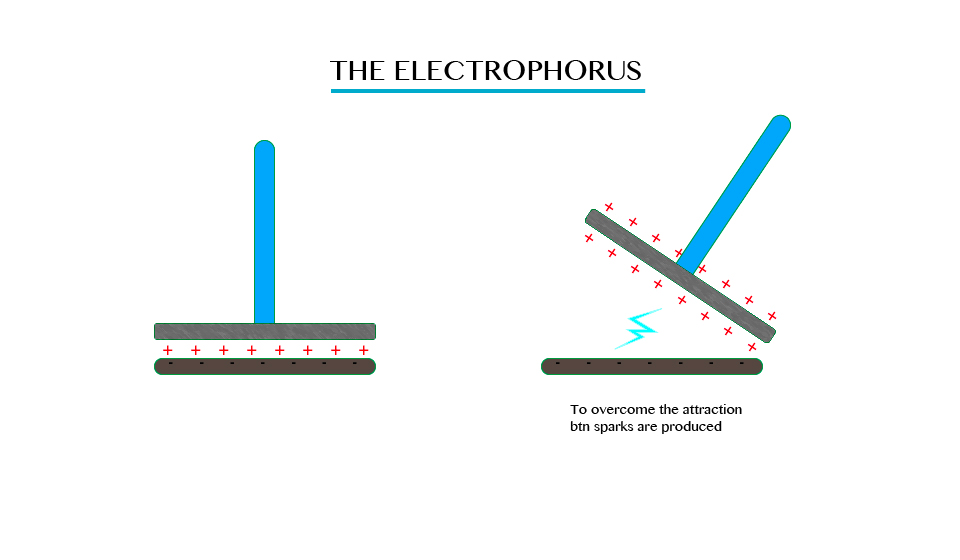
The
top of the upper disc is then touched briefly using a finger, hereby
carrying away the negative charge to the earth; this is called EARTHING.
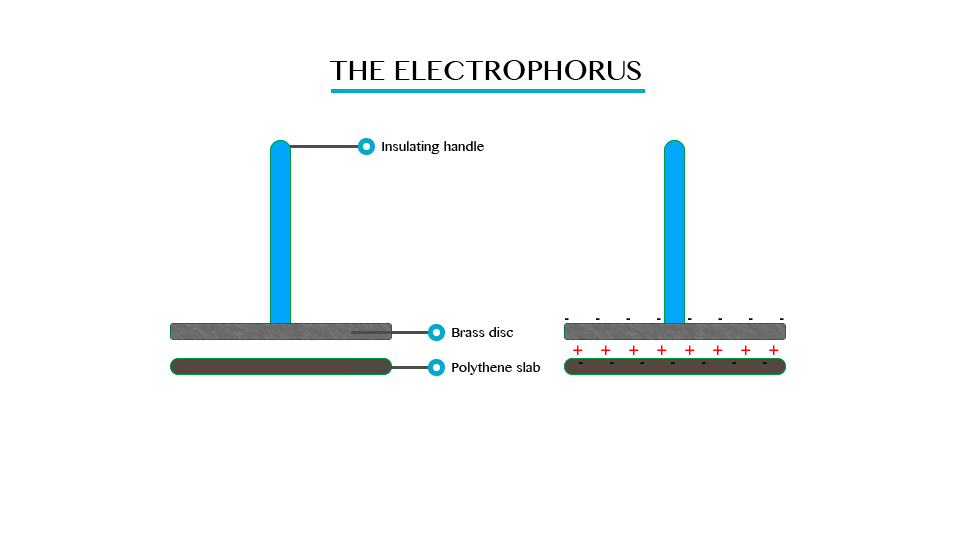
Steps of Charging and Discharging of a Gold-leaf Electroscope
Identify steps of charging and discharging of a gold-leaf electroscope
The
polythene slab is charged negative by rubbing it with fur. The brass
disc is then placed on top of the slab so that the two charges become
induced onto respective materials.
Note:Contact
does not negatively charge the disc because it is not flat and makes
contact with the slab at a few points only. When the brass disc is
touched with a finger, electrons on the upper surface are repelled to
the earth.
There
is a force of attraction between the metal disc and the base. A spark
(electric energy) is normally produced upon their separation. This spark
can be used for lighting gas burners in laboratory.
The electrophorus can now be used to charge a gold leaf electroscope.
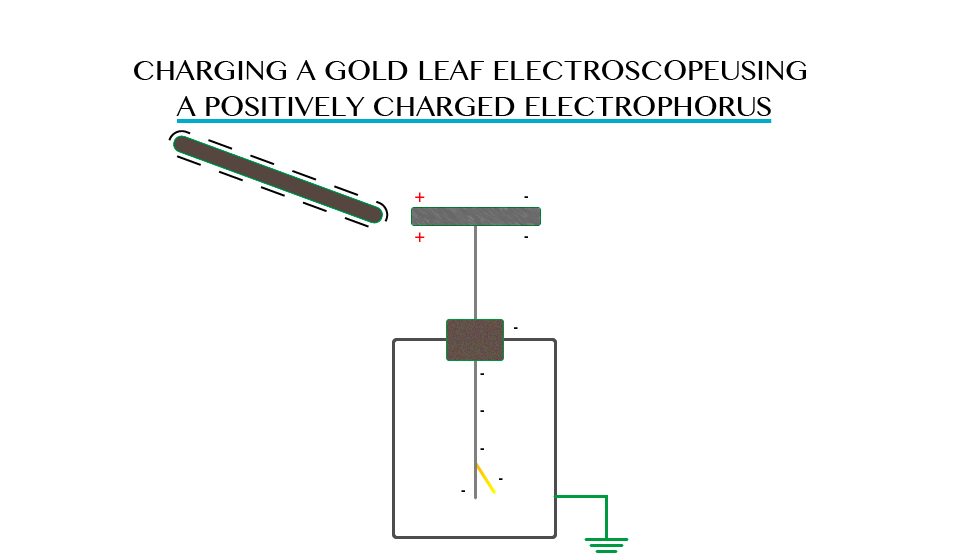
It can be used to charge a gold leaf electroscope by:
- Contact
- Induction
By contact
Here
a positively charged electrophorus is made to touch the brass cap of
the gold-leaf electroscope. The leaf of the gold-leaf electroscope
diverges.
When
a charged electrophorus is brought into contact with the electroscope,
the latter gets charged and the leaves diverge. It acquires a negative
charge. This is determined using the charged rods. When a positively
charged glass rod is brought near the cap. It causes the leaf to
collapse.
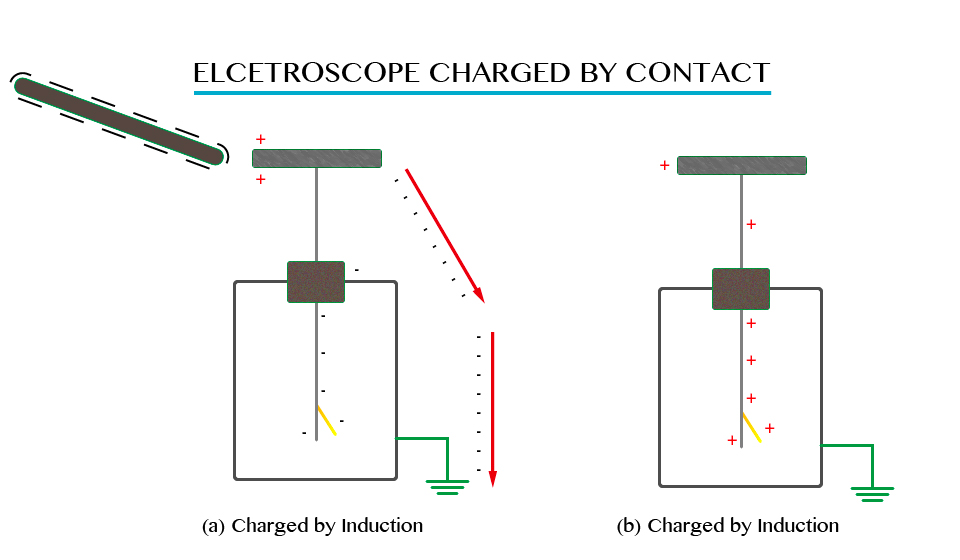
By induction
Induction- is the transfer of opposite effects from one body to another without contact.
In
order to obtain a charge of a given sign, the inducing charge must be
of an opposite charge. If charge is placed on an insulator at a given
location the excess charge will remain at the initial location. The
particles of the insulator do not permit the free flow of electrons.
Charge present in an insulator or conductor.
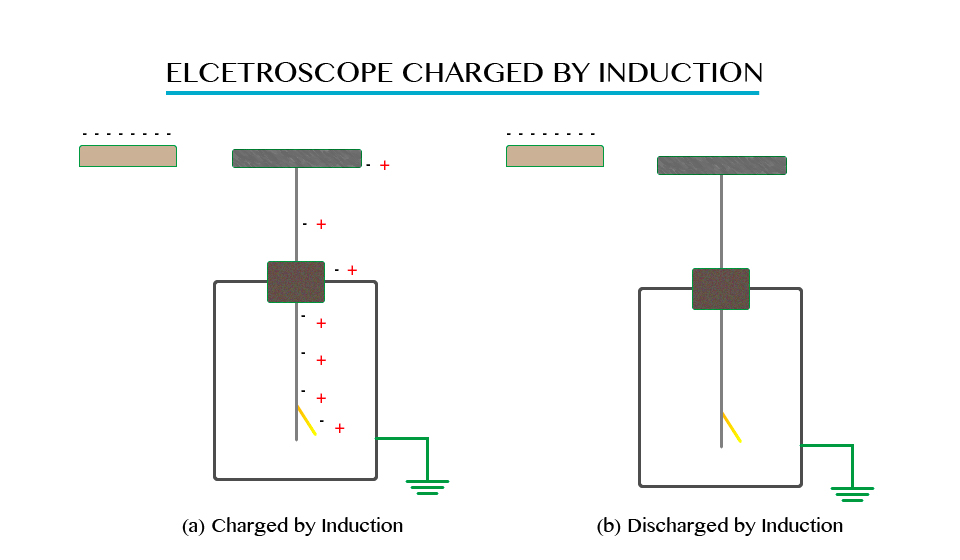
Discharging a gold leaf electroscope
Having charged a gold leaf electroscope by contact and induction, the same can be discharged effectively through induction.
If
while the electroscope is being charged by induction you touch the
brass cap, electrons will leave the electroscope through your hand and
onto the ground. If the charged metal rod is removed, the electroscope
will remain charged. The charge remaining on the electroscope will be
the opposite of the charge on the rod.
If
a negatively charged object is now brought near the brass cap electrons
in the brass cap are repelled and moved down to the leaves. This
cancels the positive charge. With no net charge, the leave collapse back
together.
If
the object is removed, the electrons return to the metal cap leaving
the leaves of the electroscope with a net positive charge again and they
separate.
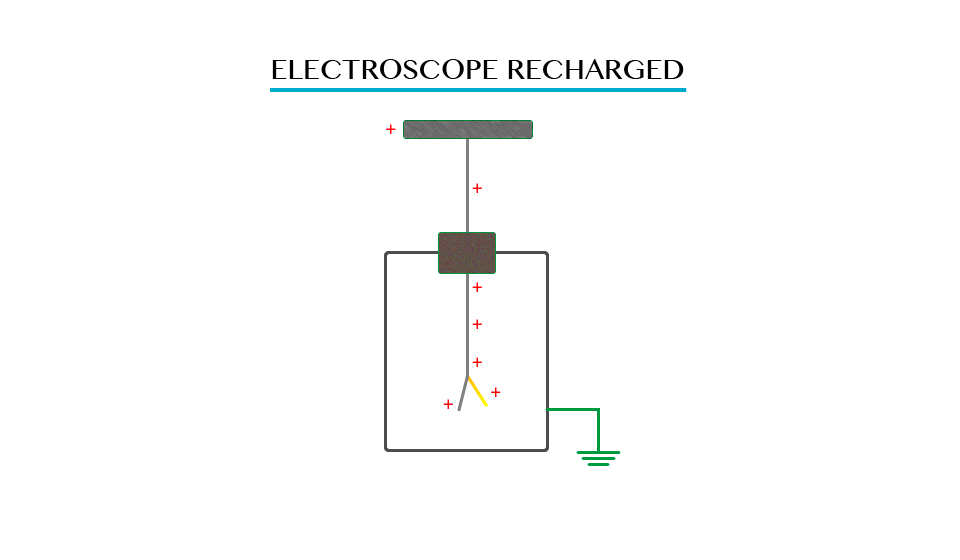
Difference between a Conductor and Insulator
Distinguish between a conductor and insulator
Conductors
Are bodies, which readily allow electric charge in motion to flow through them
OR
Are
materials that permit some electrons to flow freely from atom to atom
within the materials examples are copper, steel, iron, silver and gold.
When
there is excess of positive or negative charge on an object made of a
conducting material, the conduction electrons will move to minimise the
repulsive force.
Insulators
These
are bodies, which do not allow electric charges to flow through it.
Insulators on the other hand do not allow their electrons to flow freely
from at atom to atom; this is because the electrons in their atoms move
around their nuclei in various equal magnitudes to the charge on the
protons. The electrons are also firmly attracted to the nucleus hence
bound to these atoms.
Capacitors
The Action of a Capacitor
Explain the action of a capacitor
A
fully charged capacitor has a net positive charge on one of its plates
and a net negative charge on the other plate. The potential difference
between its plates can be measured by connecting the voltmeter across
its plates.
The
ability of a capacitor to store charges is known as the capacitance.
Capacitance is the ratio between the quantity of charge stored and the
potential difference (p.d) across the plates of the capacitor.

That means, the quantity of charges Q increases with the increase in the potential difference (p.d) across the plates.
The S.I unit of capacitance is is Farads (F). Other units include microfarads (µF), picofarads (Pf) and nanoFarads (nF).
A farad is the capacitance of a conductor that its potential difference can be changed by 1 volt by a charge of 1 coulomb.
However,
1 Farad capacitance is very large to be reached thus most of the times
the smaller units are used to simplify measurements.

Example 1
A 3µF capacitor has a 18V of potential difference. What will be its total charge?

Example 2
Calculate the capacitance of the capacitor if the cell connected to it has 1.5V when the charge is 120 coulombs.
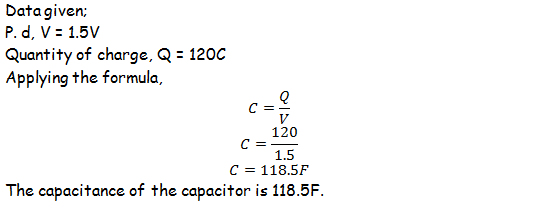
Construction of an Air-filled Capacitor
Describe the construction of an air-filled capacitor
This
constitute two parallel metal plates with air band between them.A flat
metal A is set up vertically on insulating legs and is connected to a
gold leaf electroscope by means of a wire.
The
plate is then given a positive charge by induction with a negatively
charged ebonite rod. The divergence of the leaf indicates the potential
of the plate.A second insulated plate B is now brought up slowly into a
position parallel to A.
When
B is very close to A but not touching it, it will be noticed that the
leaf divergence decreases very slightly.We conclude from this that the
potential of A has been decreased by the presence of B, and hence its
capacitance has increased slightly.
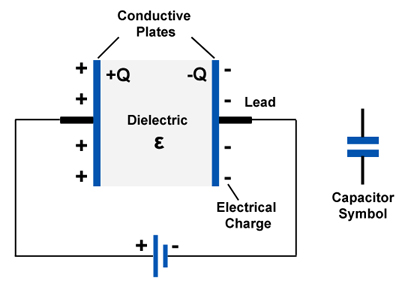
Equivalence Capacitance of a Combination of Capacitors
Determine equivalence capacitance of a combination of capacitors
Factors affecting the capacitance of a parallel-plate capacitor.
There are three factors which affect the capacitance of a parallel-plate capacitor, namely;
- Area of plates
- Distance apart of the plates.
- Dielectric between the plates.
Relative permeability (dielectric constant) of a medium
Relative permeability
is the ratio of the capacitance of a given capacitor with the medium as
dielectric to the capacitance of the capacitor with a vacuum as the
dielectric.
It
has no units since it is a ration of similar quantities.Paraffin wax
has a relative permeability of about 2 while that of mica is about 8.
Combination of capacitors
Capacitors can be combined in series or in parallel so as to prevent overheating by being continuously overcharged.
Capacitors in Series.
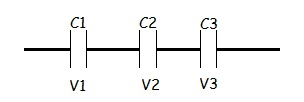
When capacitors are in series, charge distribution Q is equal to all capacitors but p.d, V and capacitance are different.
Therefore, the total p.d, VT
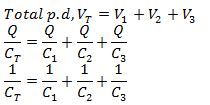
Where, CT is the equivalent capacitance (combined capacitance) for the capacitors in series.
Capacitors in Parallel.
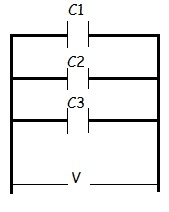
When capacitors are in parallel, potential difference V is equal to all capacitors but charge distribution, Q and capacitance are different.
Therefore, the total charge, QT

Where by, CT is the equivalent capacitance (combined capacitance) for capacitors in parallel.
Charge Distribution Along the Surface of a Conductor
Charge on a Conductor is Concentrated on Sharply Curved Surfaces
Show that charge on a conductor is concentrated on sharply curved surfaces
So
far we have considered excess charges on a smooth, symmetrical
conductor surface. What happens if a conductor has sharp corners or is
pointed? Excess charges on a nonuniform conductor become concentrated at
the sharpest points. Additionally, excess charge may move on or off the
conductor at the sharpest points.
To
see how and why this happens, consider the charged conductor. The
electrostatic repulsion of like charges is most effective in moving them
apart on the flattest surface, and so they become least concentrated
there. This is because the forces between identical pairs of charges at
either end of the conductor are identical, but the components of the
forces parallel to the surfaces are different. The component parallel to
the surface is greatest on the flattest surface and, hence, more
effective in moving the charge.
The
same effect is produced on a conductor by an externally applied
electric field, as seen inFigure(c). Since the field lines must be
perpendicular to the surface, more of them are concentrated on the most
curved parts.

Excess
charge on a nonuniform conductor becomes most concentrated at the
location of greatest curvature. (a) The forces between identical pairs
of charges at either end of the conductor are identical, but the
components of the forces parallel to the surface are different. It
isF∥that moves the charges apart once they have reached the surface.
(b)F∥is smallest at the more pointed end, the charges are left closer
together, producing the electric field shown. (c) An uncharged conductor
in an originally uniform electric field is polarized, with the most
concentrated charge at its most pointed end.
Lightning Conductor
The Structure and Mode of Action of Lightning Conductor
Describe the structure and mode of action of lightning conductor
Structure of a lightning conductor
It
consists of a long thick pointed copper rod with its lower end buried
in the earth(earth plate) and the other end reaching above the highest
part of the building and ending in several sharp spikes. -It is fixed to
the side of the building.
Mode of action of lightning conductor
When
a negatively charged thunder-cloudpasses overhead it acts inductively
on the conductor,charging the points positively and the earth plate
negatively.
The
negative charge on the plate is, of course, immediately dissipated into
the surrounding earth. At the same time point action occurs at the
spikes. Negative ions are attracted to the spikes and becomes discharged
by giving up their electrons. These electrons then pass down the
conductor and escape to earth.
At
the same time positive ions are repelled upwards from the spikes and
spread out to form what is called a space charge. This positive space
charge, however, has a negligible effect in neutralizing the negative
charge on the cloud.
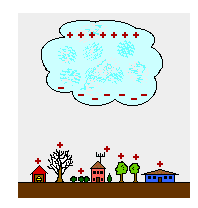
Note:Without
the protection of a lightning conductor the lightning usually strikes
the highest point, generally a chimney, and the current passes to earth
through the path of least resistance. Considerable heat is generated by
the passage of the current and sometimes it may set into fire.
A Simple Lighting Conductor
Construct a simple lightning conductor
A simple lightning conductor






No comments